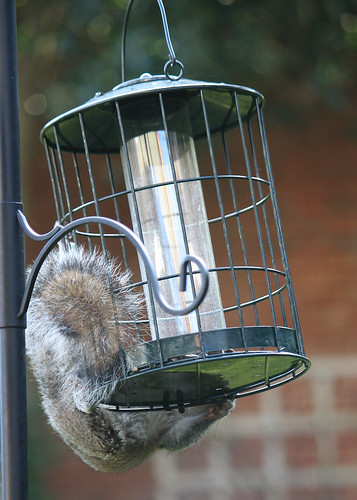The rewarding adventure of backyard bird feeding often comes with an unintended challenge: deterring crafty squirrels from monopolizing the bird food. Squirrels, with their nimble bodies, sharp claws, and superior problem-solving skills, can drain your bird feeder daily. This is not harmful per se but it deprives delicate birds of their food source and can lead to unwanted domination of your yard by these furry opportunists. To keep your bird food from becoming squirrel food, a few smart strategies can usefully deter these cheeky marauders from invading your bird feeders without inflicting any harm. So, if wondering ‘how can I effectively squirrel-proof my bird feeders’, you’re at the right place.
Firstly and notably, investing in a squirrel-proof bird feeder is one of the most effective methods. These feeders are engineered with mechanisms that close off access to the seed supply when the feeder detects weight heavier than a bird, usually a squirrel. The gravity-fed approach ensures that when a squirrel hops onto the feeder, their weight pulls down a shield that blocks access to the food. At the same time, it does not deter lighter birds from feeding as their weight does not trigger the mechanism. Such feeders may be slightly more expensive but they provide a long-term solution for deterring squirrels.
In addition to using specially designed bird feeders, the correct positioning of the bird feeder can also contribute significantly to making it squirrel-proof. Squirrels can leap distances of up to 10 feet horizontally and are adept climbers so your bird feeder should ideally be placed at least 10 feet away from any launch points like roofs, fences, trees, or other high platforms that squirrels could use to jump from. Also, hanging the bird feeder from a smooth metal pole of at least 6 feet high and attaching a squirrel baffle (a dome-shaped object) towards the top can make it more difficult for the squirrel to access the feeder. The pole should also be about 5 feet off the ground.
The food you choose for your bird feeder can also be a useful deterrent. Safflower seeds, nyjer seeds, and thistle seed are some foodstuff that typically attract birds but are less appealing to squirrels. Moreover, there are bird foods available in the market that are infused with hot pepper—while birds are not affected by the heat, mammals such as squirrels are deterred by the spiciness. However, do ensure to wash your hands thoroughly after handling and remember, homemade spicy foods can harm birds and so are not advised.
Another method is to use a squirrel spinner, also known as a twirl-a-squirrel. This is a battery-powered system that spins the bird feeder when a squirrel tries to gain access. The spinning movement throws the squirrel off and discourages it from attempting to invade the feeder again. It’s also quite entertaining to watch!
Squirrel domes or baffles are accessories that can be added to your feeding station. Baffles are obstaclrs that block the squirrel’s path to the feeder. They can be cone, disk, or dome shaped and are installed either below or above the feeder, making it harder for the squirrels to climb down to the feeder or jump onto it.
Whilst our goal is to squirrel-proof the bird feeders, it is also important to ensure the ground under the feeder is kept clean. Any spillages should be cleaned up immediately to avoid attracting squirrels to the area.
Finally, offering squirrels their own special feeders located far away from the bird feeders might be a way to distract them. Squirrels love corn, so a feeder offering dried corn cobs could work as a great diversion. Remember, the goal is not to starve the squirrels but to maintain a balanced backyard ecosystem. The backyard is their home too.
The task of squirrel-proofing your bird feeders needs some strategic planning and patience. But, when applied effectively, these strategies can help you manage an ideal setup for your feathered friends and furry neighbors to thrive harmoniously. Happy bird feeding!
Squirrel in Action 1
By Mike Legend on 2010-03-15 08:38:07
